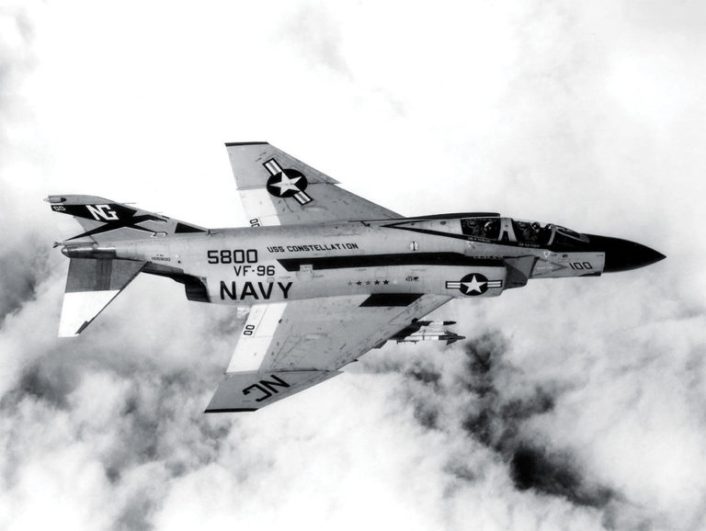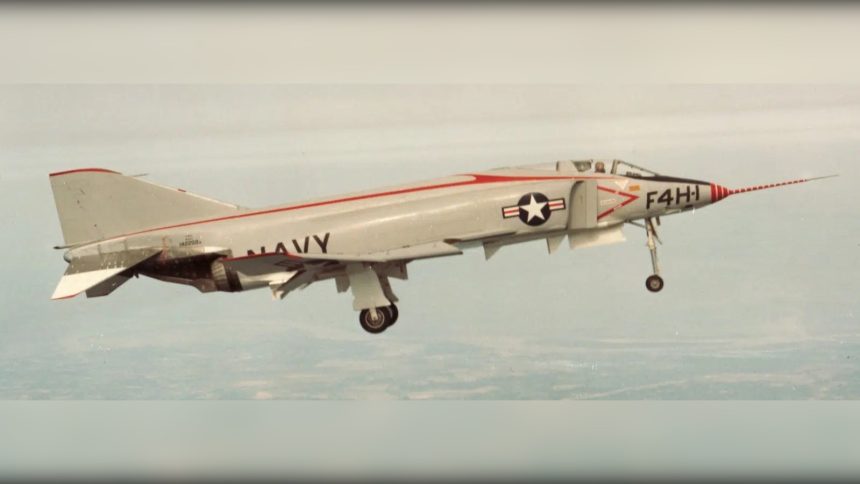Looking more like a killer than a speedster, the large twin-engine jet built to sweep skies clear of enemy MiGs and deliver large payloads of bombs would also record many “firsts.”
Overachiever from the Beginning
Out of a requirement for an all-weather fleet defense interceptor, McDonnell Douglas developed the XF4H-1 twin-engine two-seat test aircraft. In July 1955, the United States Navy (USN) ordered two XF4H-1 test examples along with five YF4H-1 pre-production aircraft. Test flights would begin on May 27, 1958. The aircraft would become known as Phantom II and later referred to as simply Phantom.
On Dec. 6, 1959, during Project Top Flight, Commander Lawrence E. Flint Jr. of the USN would set a Fédération Aéronautique Internationale (FAI) world altitude record during a zoom climb of 98,556 ft while flying the second produced YF4H-1 (142660) at Edwards Air Force Base (AFB) California. The previous record of 94,658 ft was held by Soviet pilot Vladmir Sergeyevich Ilyushin in a Sukhoi T-43-1, a prototype of the Su-9 all-weather interceptor.
Flint had accelerated to Mach 2.5 in level flight and pulled into a 45 degree climb to 90,000 ft, shutting down the two General Electric J79-GE-2 engines in the thin atmosphere to prevent overheating. The aircraft continued on reaching the 98,556 ft. mark before diving back to lower altitudes, allowing Flint to restart the engines and return to Edwards AFB.
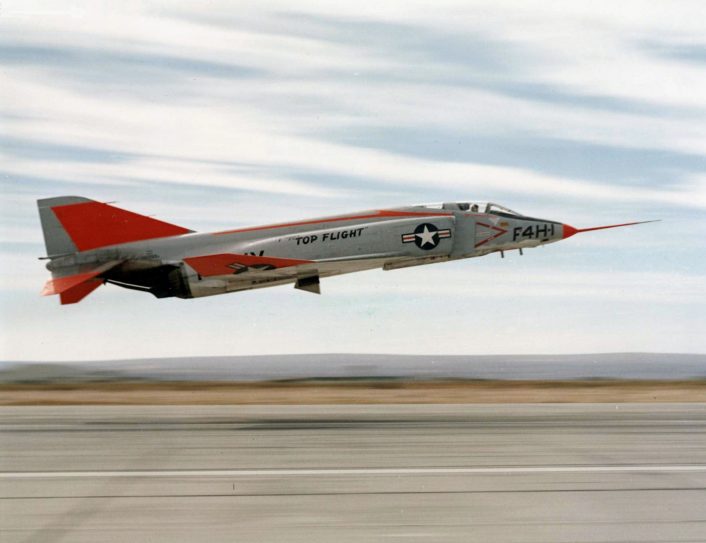
On Sept. 5, 1960, Marine Corps pilot Lieutenant Colonel Thomas H. Miller took YF4H-1 142660 to a new speed record of 1,216.76 mph. Centerline and wing mounted drop tanks were carried, with the wing tanks being jettisoned before the acceleration phase and the centerline tank left attached. About 150 miles from the start line of a 500 km (311 mi) closed circuit course, Miller lit the afterburners at 36,000 ft and Mach 0.92. After about 120 miles, the aircraft was at 48,000 ft and had accelerated to Mach 1.6, at the centerline tank was now jettisoned. At the actual start line, the YF4H-1 was at Mach 1.76 at a lower altitude of 42,200 ft. 15 minutes and 19.2 seconds later, the finish line was crossed at Mach 2.1 after a sustained afterburner run of over 25 minutes.
On Sept. 26, 1960, Navy Commander J.F. Davis set a new speed record in aircraft 142660 at Edwards AFB of 1,390.24 mph when flying a 100 km (62.1 mi) closed circuit circular course at an altitude of 45,000 ft. Davis held a 3g turn while taking the aircraft all the way around to 47,000 ft.
Continued Record Setting Successes
Project LANA was an acronym for the 50th (Roman numeral L) anniversary of American Naval Aviation and, in order to celebrate the occasion, on May 24, 1961, three Phantom aircraft would fly from Ontario Field, near Los Angeles, California to Bennet Field, New York. The distance was 2,446 miles and the attempt would allow subsonic in-flight refueling over New Mexico, Missouri, and Ohio, with a maximum speed dash at 35,000 ft. The fastest aircraft made it in 2 hours and 47 minutes, flown by pilot Lt. Richard Gordon and Lt. Bobbie Young as the Radar Intercept Officer (RIO) at an average speed of over 869 mph, winning the Bendix Trophy.
Aug. 28, 1961 would see another record set during Project Sageburner. Phantom 145307 flown by Navy Lt. Huntington Hardisty as pilot and Lt. Earl De Esch as RIO would leave Holloman AFB in New Mexico and set a low-level record averaging 902.76 mph. The course was 3 km (1.86 mi) over White Sands Missile Range, consisting of four passes. The altitude was not to exceed 328 ft, however Hardisty flew at a maximum of 125 ft, making this one of the most dangerous attempts to set a record. The first attempt at this record cost Commander J.L. Felsman his life when pitch dampener failure led to the aircraft breaking up in flight and exploding on May 18. Aircraft bureau number 145307 was preserved when it was handed over to the Nation Air and Space Museum and is currently in storage.
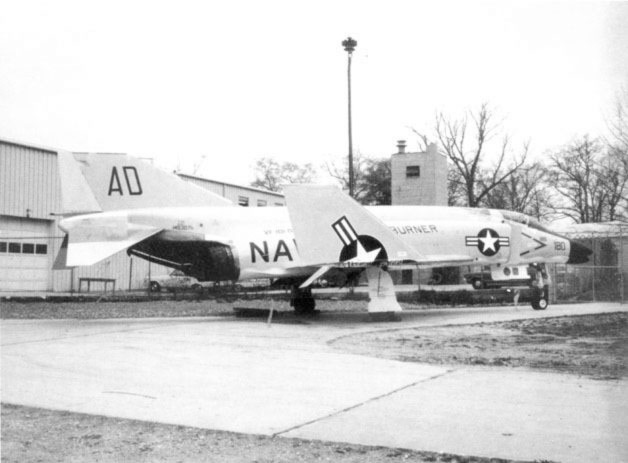
Phantom 142660 would go on to set another FAI record on Nov. 22, 1961, when Lieutenant Colonel Robert B. Robertson of the United States Marine Corps (USMC) averaged 1,606.509 mph at Edwards AFB during a straight course run, and reached a maximum speed of over 1,700 mph during Project Skyburner. The more powerful J79-GE-8 engines had been fitted along with the installation of a water/alcohol spray system to cool the air ahead of the compressors. Later on in December, Commander George W. Ellis of the USN would set the World Record for Altitude in Horizontal Flight when he took YF4H-1 number 142660 to 66,444 ft on a measured course at Edwards AFB.
Project High Jump
Project High Jump would see a series of time-to-altitude records set by both USN and USMC pilots between Feb. 21 and Apr.12, 1962. A total of eight records were set, with the first five set by Phantoms from NAS (Naval Air Station) Brunswick, Maine, the remaining three from NAS Point Mugu in California.
On Feb. 21, Lt. Commander John Watts Young took the Phantom to 9,842 ft. in 34.52 seconds, along with a record set on the same day by Commander David Langton who went to 19,685 ft in 48.78 seconds. A few days later, on Mar. 1, three more records would be set flying Phantoms. The altitude of 29,527 ft was reached in 1 minute 1.62 seconds by Lt. Colonel W. McGraw, as well as 39,370 ft in 1 minute 17.15 seconds by the same pilot. Lt. Commander Del Nordberg also set a record on Mar. 1, when he made an altitude of 49,212 ft in 1 minute 54.54 seconds. On Mar. 31, Lt. Commander Taylor Brown went to 65,616 ft in 2 minutes 58.5 seconds for a record. Lt. Commander Young again set a record on Apr. 3 when he reached 82,021 ft in 3 minutes 50.44 seconds in an F4H-1. Lt. Del Nordberg set another record on Apr. 12 when he reached 98,424 ft in 6 minutes 11.43 seconds.
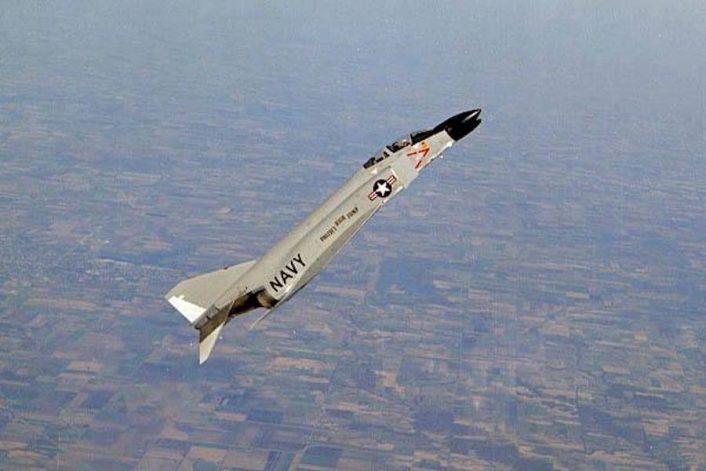
Other Phantom Firsts
The F-4 Phantom was one of the first Navy aircraft to have a non-pilot RIO or also known as the GiB (Guy in Back). The Phantom was also the mount of Lt. Randy “Duke” Cunningham and William P. Driscoll when, flying a Navy F-4J variant with the call sign “Showtime 100”, they achieved ace status by downing three MiG-17s on May 10, 1972. These three MiG kills made Cunningham and Driscoll the first American air aces of the Vietnam War.
Earlier in the war, on July 10, 1965, F-4Cs had scored the first United States Air Force kills against North Vietnamese MiG-17s using AIM-9 Sidewinder missiles. The first North Vietnamese MiG-21 was also downed by an F-4C on Apr. 26, 1966. On the downside, the F-4 was also the first American aircraft lost to an enemy SAM (Surface-to-Air Missile) on July 24, 1965. Another F-4C was the first American jet lost to an air-to-air missile when a MiG-21 fired at it on Oct. 5, 1966.
Capt. Steve Ritchie became the first USAF ace of the war on Aug. 28, 1972 in a Phantom. The highest scoring ace of the Vietnam War was Phantom Weapons System Officer (WSO) Capt. Charles B. DeBellevue for the USAF with six victories, achieving his last kill on Sept. 9, 1972. A MiG-19 was gunned down by Maj. Phil Handley flying a Phantom at Mach 1.2 on June 2, 1972. This was the first and only recorded gun victory while flying at supersonic speeds. The F-4 Phantom is also the only aircraft to date to fly simultaneously with both the USAF Thunderbirds and the Navy Blue Angels. The F-4 Phantom has had a long and distinguished career, setting many records and achieving many firsts serving the United States and her allies with distinction.
